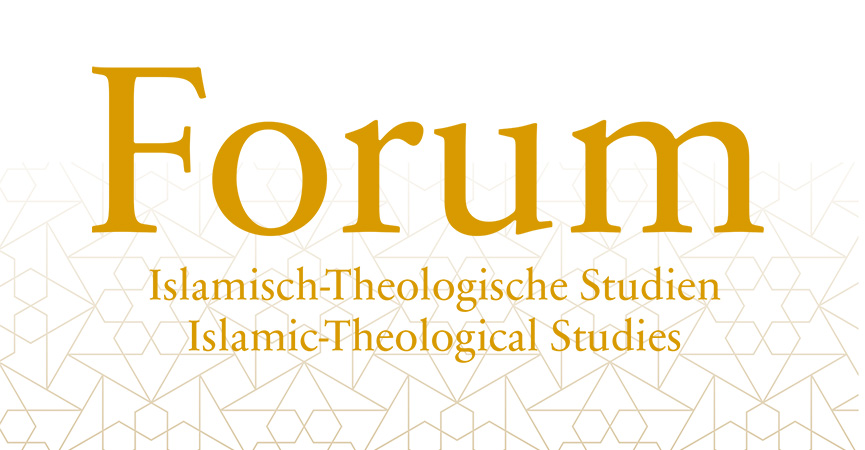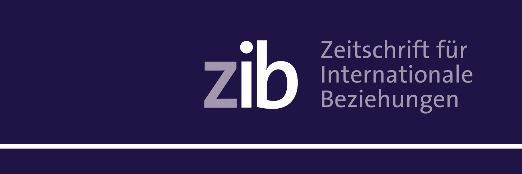Journals
-
German Journal of Forced Migration and Refugee Studies
Die Zeitschrift für Flucht- und Flüchtlingsforschung. German Journal of Forced Migration and Refugee Studies (Z’Flucht) ist ein peer-reviewed journal, das wissenschaftliche Beiträge aus unterschiedlichsten Disziplinen zu Fragestellungen der Flucht- und Flüchtlingsforschung veröffentlicht. Sie erscheint zweimal im Jahr im Nomos-Verlag und wird von Marcel Berlinghoff, Valentin Feneberg, Birgit Glorius, Judith Kohlenberger, Annette Korntheuer und Hannes Schammann in Verbindung mit dem Netzwerk Fluchtforschung e.V. herausgegeben.
-
Journal of Service Management Research
The Journal of Service Management Research (SMR) is a forum for academic dialogue among researchers from various business disciplines focusing on services. The journal provides critical accounts of the latest developments in key areas of service research. SMR explicitly pursues an interdisciplinary research agenda.
Objectives of the journal in the publication process:
- SMR is committed to interdisciplinarity. Articles are published that comprehensively discuss economic topics related to service research. Contributions from disciplines other than management – engineering, psychology, economics – are explicitly encouraged, as long as they address economic topics.
- SMR explicitly aims to promote and initiate interdisciplinary research. This is to be done in scientific societies and in cooperation with organizers of scientific conferences and (annual) meetings.
- SMR sets high quality standards. A high reputation and the rating “B-Journal” for scientific journals are aimed for.
- SMR also publishes articles with specific European relevance, e.g. articles on service industries and sectors, which are particularly widespread in Europe.
- Both conceptual theoretical and empirical papers are represented in the SMR. The intention is to achieve a balance between the different types of contributions. The same applies to contributions on basic research and applied science.
- Articles published in the SMR undergo a peer review process. SMR guarantees a fast, high quality and fair review process. The authors and editors are guaranteed a high degree of transparency. The peer review process takes an average of eight weeks.
Please find further information about the SMR on our website:
Website – Journal of Service Management Research -
Industrielle Beziehungen
Die Zeitschrift Industrielle Beziehungen bietet allen an den industriellen Beziehungen Interessierten ein aktuelles Forum der Analyse und Diskussion.
-
Technikgeschichte
Technikgeschichte ist die deutschsprachige Fachzeitschrift für technikhistorische Forschung. Im Jahr 1909 als „Jahrbuch Technikgeschichte“ begründet, ist die Zeitschrift heute das traditionsreichste deutsche Fachperiodikum, das sich dem gesamten Fachgebiet der Technikgeschichte von den Anfängen bis zur Gegenwart widmet. Sie wendet sich mit ihrem interdisziplinären Konzept nicht nur an Technikforscher*innen und Technikhistoriker*innen, sondern auch an Sozialwissenschaftler*nnen aller Teildisziplinen, an Akteure der technischen Entwicklung u.a. in Verbänden, Unternehmen und der Politik sowie an interessierte Laien, die den technisch-sozialen Wandel in seiner Einbindung in den historischen Prozess reflektieren wollen.
Technikgeschichte veröffentlicht ausschließlich Originalbeiträge über die geschichtliche Entwicklung der Technik in ihren wissenschaftlichen, gesellschaftlichen, wirtschaftlichen und politischen Zusammenhängen. Die Zeitschrift erscheint viermal pro Jahr jeweils zum Quartalsende. Alle Beiträge durchlaufen vor der Veröffentlichung ein anonymisiertes Begutachtungsverfahren.
Für Beitragseinreichungen verwenden Sie bitte den folgenden Link:
-
Forum Islamisch-Theologische Studien / Forum Islamic-Theological Studies
Forum Islamisch-Theologische Studien ist eine internationale und interdisziplinäre Fachzeitschrift, deren Ziele die Förderung des wissenschaftlichen Diskurses und die Konzeptualisierung der Islamischen Theologie und Religionspädagogik insbesondere im europäischen Kontext sind. Bekenntnisübergreifend, multiperspektivisch und dialogisch ausgerichtet, versteht sie sich als Plattform für hermeneutische Analysen und Reflexionen sowie für empirische Arbeiten, die auf die Erforschung der Lebenswirklichkeit gerichtet sind und Grundlagen für neue Konzepte in der Islamischen Theologie und Religionspädagogik liefern – auch und gerade im Austausch zwischen traditioneller islamischer Gelehrsamkeit und den Themen und Ansätzen der Gegenwart.
Das Forum Islamisch-Theologische Studien unterstützt die wissenschaftliche Etablierung und Weiterentwicklung der islamisch-theologischen Studien und deren Eingliederung in die akademische Tradition Europas.
Für Einreichungen bitte den folgenden Link benützen: https://ojs.nomos-journals.de/index.php/fits/about/submissions
-
Jahrbuch Technikphilosophie
Das Jahrbuch Technikphilosophie soll Forschungsbeiträgen und Debatten ein zentrales, weithin sichtbares Forum bieten. Es repräsentiert das gesamte Spektrum der Disziplin von avancierter Theorie und Reflexion der Rolle der Technik in Wissenschaft und Lebenswelt über die STS-Forschung bis zu Analysen technikpolitischer und technikethischer Entwicklungen. Es beabsichtigt, die philosophisch relevanten (und entsprechend kontextualisierten) Thesen, Ansätze und Forschungslinien abzubilden.
Das Jahrbuch setzt Akzente in Form von Themenschwerpunkten; daneben wird durch Abhandlungen das Spektrum aktueller Forschungsaktivitäten repräsentiert. Durch ein Begutachtungsverfahren (double-blind peer review) wird eine hervorragende Qualität der Texte sichergestellt. Klassische, aber vergriffene, unbekannte, aber lohnenswerte Texte der Technikphilosophie werden in der Rubrik Archiv zugänglich gemacht. Durch einen profilierten Rezensionsteil soll die aktuelle Entwicklung der Technikphilosophie reflektiert und mitbestimmt werden.
-
Studies in Communication and Media
Die SCM ist das Open Access Journal der Deutschen Gesellschaft für Publizistik- und Kommunikationswissenschaft (DGPuK) und Affiliate Journal der International Communication Association (ICA). Die SCM repräsentiert die gesamte theoretische, methodische und inhaltliche Bandbreite der Kommunikationswissenschaft. Die Zeitschrift erscheint viermal pro Jahr jeweils zum Quartalsende. Alle Beiträge durchlaufen vor der Veröffentlichung ein anonymisiertes Begutachtungsverfahren.
Beiträge können im persönlichen Bereich ("dashboard") der Manuskriptverwaltung eingereicht werden: Registrierung/Login
Die SCM akzeptiert Manuskripte in den Formaten „Research-in-brief“, „Full Paper“ und „Extended Paper“.
-
Diyâr - Zeitschrift für Osmanistik, Türkei- und Nahostforschung
Diyâr ist eine interdisziplinäre und Regionen übergreifende wissenschaftliche Fachzeitschrift, herausgegeben von der Gesellschaft für Turkologie, Osmanistik und Türkeiforschung e.V. (GTOT). Die Zeitschrift beschäftigt sich mit der Türkei, dem Osmanischen Reich und seinen Nachfolgestaaten, Iran, Zentralasien und dem Kaukasus sowie den Sprachen und Kulturen, der Geschichte und Gegenwart der unterschiedlichen turk- und iranischsprachigen Volksgruppen, Dynastien und Staaten sowie anderer in diesen Staaten lebender ethnolinguistischer und religiöser Gruppen.
Diyâr veröffentlicht unpublizierte Originalbeiträge aus den Geistes-, Kultur- und Sozialwissenschaften mit disziplinären Schwerpunkten in der Geschichtswissenschaft, Literaturwissenschaft, Soziolinguistik, Politikwissenschaft, Soziologie, Wirtschaftswissenschaft, Kulturanthropologie/Ethnologie, Religions- und Musikwissenschaft, Kulturgeographie sowie in der Erziehungs- und Rechtswissenschaft.
-
Die Unternehmung
Die Unternehmung zählt mit ihrem Konzept, theoretischen Anspruch und Praxisrelevanz in qualitativ hochwertigen Beiträgen zu verbinden, zu den führenden deutschsprachigen Fachzeitschriften der Betriebswirtschaftslehre.
Zum Themenspektrum der Zeitschrift gehören sowohl die Kernfächer der BWL (z.B. Marketing, Rechnungswesen/Controlling, Organisation und Unternehmensführung) als auch neuere Gebiete wie Technologie- und Innovationsmanagement sowie Logistik und Supply Chain Management. Sie verfolgt das Ziel, neue Erkenntnisse der betriebswirtschaftlichen Forschung zu verbreiten, auf wichtige Problemstellungen in der Unternehmenspraxis aufmerksam zu machen, wissenschaftlich fundierte Lösungsansätze für die Praxis vorzustellen und allgemein den Austausch zwischen Wissenschaft und Praxis zu fördern.
Die Unternehmung richtet sich an Studierende und Dozierende an Universitäten und Fachhochschulen sowie an Praktiker der Betriebswirtschaft.
-
UFITA - Archiv für Medienrecht und Medienwissenschaft
Die UFITA wurde 1928 als „Archiv für Urheber-, Film- und Theaterrecht“ gegründet und gehört seitdem zu den führenden Zeitschriften zum Recht des Geistigen Eigentums. Ab dem Jahr 2018 erscheint sie als interdisziplinäre Zeitschrift für Medienrecht und Medienwissenschaft.
Als forschungsorientierte Archivzeitschrift mit wissenschaftlich höchstem Anspruch bietet die UFITA ein Forum für grundlagenorientierte Abhandlungen zum privaten und öffentlichen Urheber- und Medienrecht mit seinen interdisziplinären Bezügen sowie zur sozialwissenschaftlich orientierten Kommunikations- und Medienwissenschaft.
In Aufsätzen und Gutachten namhafter Autoren werden grundlegende Fragestellungen und aktuelle Entwicklungen in der Urheber- und Medienrechtswissenschaft mit ihren rechtsphilosophischen, rechtshistorischen, methodologischen sowie ökonomischen Grundlagen adressiert. Gleichzeitig ist die UFITA künftig auch ein Forum, das interdisziplinäre Diskussionen sowie Publikationen auf dem Gebiet der Medien- und Kommunikationswissenschaft ermöglichen soll. Die Verbindungen zu internationaler Forschung sowie ein spezieller, auch rechtsvergleichender Fokus auf das europäische Recht und das Völkerrecht sind daher ebenso wichtig wie die Präsenz von WissenschaftlerInnen verschiedener disziplinärer Herkunft.
Die UFITA hat einen Jahresumfang von ca. 300 Seiten, erscheint halbjährlich und enthält neben umfangreichen wissenschaftlichen Abhandlungen vertiefte Rezensionen zu ausgewählten Veröffentlichungen, die thematisch geordnet in Sammelrezensionen diskutiert werden. Des Weiteren findet sich in jeder Ausgabe eine deutsche und internationale Literaturübersicht, eine Zeitschriftenlese sowie ein Überblick aktueller Entscheidungen. Angestrebt wird eine Erweiterung um englischsprachige Beiträge.
Die UFITA ist daher eine ideale Basis für sämtliche juristischen Berufszweige und all jene aus Wissenschaft und Praxis, die sich vertieft mit aktuellen Fragen der Medienentwicklung und -steuerung befassen.
-
ZIB Zeitschrift für Internationale Beziehungen
Über die Zeitschrift
Die Zeitschrift für Internationale Beziehungen (zib) ist der Publikation fachwissenschaftlicher Artikel verpflichtet, die ein breites Spektrum an Forschungsfragen im Bereich der Internationalen Beziehungen behandeln. Die zib versteht sich als zentrales Forum der deutschsprachigen Disziplin, in dem eine Vielfalt an Perspektiven präsentiert und diskutiert werden. Leitend ist die grundlegende Prämisse, dass die zib die theoretische und methodische Vielfalt der Internationalen Beziehungen in all ihren Teilbereichen widerspiegeln soll. In der zib veröffentlichte Artikel sind theoretisch informiert, empirisch fundiert und methodologisch versiert, wobei immer auch die Grenzen der Disziplin durch theoretische, konzeptuelle oder methodologische Innovationen erweitert werden können.
Die zib wird herausgegeben im Auftrag der DVPW-Sektion Internationale Beziehungen.
Die zib erscheint zweimal im Jahr. Alle Beiträge werden doppelt anonym begutachtet.
-
Soziale Welt
Die Soziale Welt gehört zu den führenden soziologischen Fachzeitschriften im deutschsprachigen Raum. Sie zeichnet sich durch einen klaren empirischen Fokus aus und publiziert Beiträge, die darauf abzielen, auf Grundlage qualitativen und quantitativen Datenmaterials gesellschaftliche Verhältnisse, Zusammenhänge und Veränderungen zu beschreiben, zu erklären und zu verstehen. Die traditionsreiche Zeitschrift hat den Anspruch, der Soziologie durch programmatische Beiträge neue Impulse zu geben und die Entwicklung des Faches aktiv mitzugestalten.
Die Soziale Welt wird im Social Sciences Citation Index und in Scopus erfasst.
-
Knowledge Organization
KNOWLEDGE ORGANIZATION is a forum for all those interested in the organization of knowledge on a universal or a domain-specific scale, using concept-analytical or concept-synthetical approaches, as well as quantitative and qualitative methodologies. KNOWLEDGE ORGANIZATION also addresses the intellectual and automatic compilation and use of classification systems and thesauri in all fields of knowledge, with special attention being given to the problems of terminology.
-
Voluntaris. Zeitschrift für Freiwilligendienste und zivilgesellschaftliches Engagement
Zeitschrift für Freiwilligendienste und zivilgesellschaftliches Engagement





